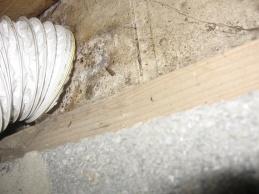Not sure if this topic might be suited to a different forum, but I'll try it here...
I was up in the attic today, and was looking at the vent pipe for the ensuite, and noticed that it was sagging in a couple of places. Turns out there was water in a few spots.
Anyway, I went to the end of the pipe, and noticed that it just ends where you can see in the picture, going down onto what looks like plasterboard. Is this normal building practice? I understand there wouldn't normally be a huge amount of water gushing out of there, but there was a fair bit today, when the water in the sags was displaced.
There are vents on the underside of the fascia, I can see them from outside the house, so are these vents supposed to disperse moisture from the flexi-pipe?
I was thinking of connecting the flexi to the toilet vent, which is vented through a roof tile, but maybe sewer smells could then come into the ensuite through the flexi-pipe?
Or is my only other option to ensure that there is a gradual slope in the flexi-pipe so that the moisture extracted by the fan is dispersed gradually?
I was up in the attic today, and was looking at the vent pipe for the ensuite, and noticed that it was sagging in a couple of places. Turns out there was water in a few spots.
Anyway, I went to the end of the pipe, and noticed that it just ends where you can see in the picture, going down onto what looks like plasterboard. Is this normal building practice? I understand there wouldn't normally be a huge amount of water gushing out of there, but there was a fair bit today, when the water in the sags was displaced.
There are vents on the underside of the fascia, I can see them from outside the house, so are these vents supposed to disperse moisture from the flexi-pipe?
I was thinking of connecting the flexi to the toilet vent, which is vented through a roof tile, but maybe sewer smells could then come into the ensuite through the flexi-pipe?
Or is my only other option to ensure that there is a gradual slope in the flexi-pipe so that the moisture extracted by the fan is dispersed gradually?



